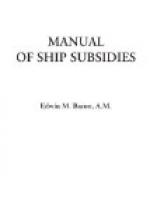As the end of the term of this law was approaching ship-owners began agitating for its renewal with an increase in the subsidy. Since its enactment the production of steam tonnage had been accelerated, and the decline of sail tonnage had been checked; but no marked change in the merchant marine generally had been manifest.[DH] Of the bounties paid the Austrian Lloyd had received a large share in behalf of their ships which were not directly under contract for the mail service. The remainder went to the various companies controlling the coast and river trade. The ten to twenty-five per cent addition to the trade bounty for ships built in domestic yards and from domestic materials, finally went for the most part to a single large building concern at Trieste. While most of the Austrian tonnage was yet of foreign build, mostly constructed in British yards, the increase in the proportion of domestic build was considerable after 1893. The greater part of the materials used was Austrian product. Consequently allied industries increased with this increased output of home ships.[DI]
At length in 1907 (February 23) a new law was enacted increasing the navigation and construction bounties. For the navigation subsidies, to go to shipowners according to the tonnage of the ships and the number of miles run, allotments were thus made: for the first year, $852,600; for 1908, $893,200; 1909, $954,100; 1910, $1,015,000; 1911, $1,075,000; and for the five years remaining of the term, of the law—which ends December 31, 1916—$1,136,800 a year. The construction subsidies were raised as follows: for ships launched after July 1, 1907: steamers built of iron and steel $8.12 per gross ton, sailing-ships of iron and steel, $2.84; for marine engines, boilers, pipes, and auxiliary apparatus, $1.62 per 220.46 pounds. To entitle a ship to these bounties fifty per cent of the materials used in its construction must be home product.[DJ]
This year (1907) also the annual postal subventions to the Austrian Lloyd were increased $1,486,586, for a further period of fifteen years. This contract called for an increase of speed to the Levant and the Orient. The Suez Canal tolls were to be paid by the Government as before.




